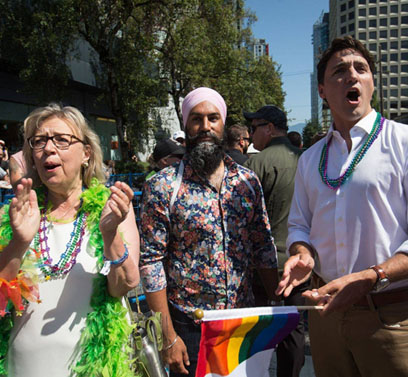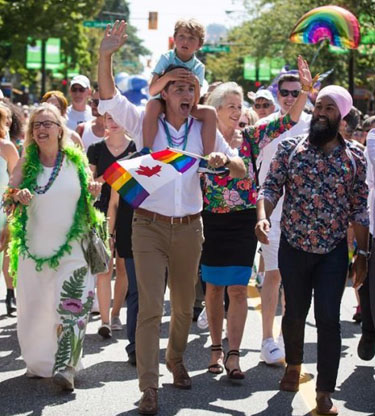Did Vancouver Pride Parade prefigure next federal government in Canada?
Aug 6th, 2019 | By Counterweights Editors | Category: Ottawa SceneIt’s the early days of August – “for the people and their favourite islands.” Beyond the great but too often sad entertainment of current American history next door, no Canadian of any sense is thinking about anything at all serious. And that certainly goes double for the Canadian federal election this coming October 21.
Photographs from the August 4, 2019 Pride Parade in beautiful Vancouver, however, are bound to make at least some of we alleged close observers wonder. Are the buoyant images of Justin Trudeau, Jagmeet Singh, and Elizabeth May almost walking arm in arm, along certain sections of the parade route, hinting at something interesting enough about the October election outcome?
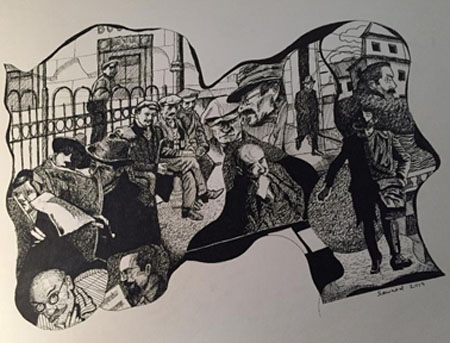
It does fit with the month of the people and their favourite islands that Éric Grenier’s illustrious CBC “Poll Tracker is on hiatus until Aug. 12.” And a few major polls are still stuck in July.
It is worth remembering as well that October 21 is still a few moons ahead. At this mid-summer point in the year during the last Canadian federal election in 2015, eg, Thomas Mulcair’s New Democrats were leading in the polls, and their serious rivals were the governing Stephen Harper Conservatives. On August 2, 7, 10, and 11, 2015 the Justin Trudeau Liberals who ultimately won a majority government on the then October 19 election day were still in third place!
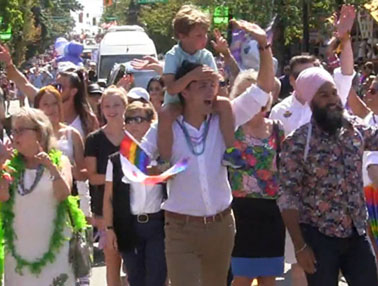
All that having been said, CalculatedPolitics.com and 338Canada.com are currently offering polling-based guesses about the actual October 21, 2019 election outcome, dated August 1 and 4. Both guesses arguably add some further intrigue to the 2019 Vancouver Pride Parade photos of Liberal leader (and current PM) Justin Trudeau, New Democrat leader Jagmeet Singh, and Canada Green Party leader Elizabeth May.
The polls generally at the moment seem to agree on two things. One is that the main competition this year is between the Trudeau Liberals and Andrew Scheer’s Conservatives, with the NDP some distance behind, closer to the Greens who appear to be rising.
(And then with M. Bernier’s People’s Party and the Bloc Québécois further back again. Note as well that all this is different from even early August 2015, when the race was much more of a three-way competition, with the Conservatives, New Democrats, and Liberals bunched together at the top.)
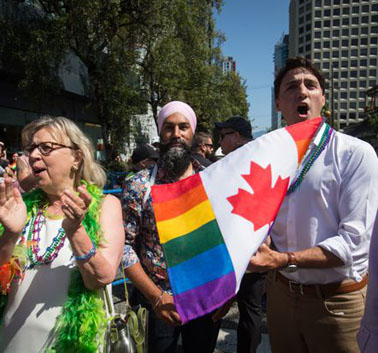
Another thing current polls generally seem to agree on is that neither the Liberals nor Conservatives – as matters stand right now – are at all close to a majority government. And, most recently, both CalculatedPolitics.com and 338Canada.com are offering polling-based guesses about the October 21, 2019 election that give the Liberals a minority government.
To start with, note that a bare majority in the present 338-seat Canadian House of Commons is 170 seats. From here, CalculatedPolitics.com (“last updated: Thursday, August 1, 2019”) gives the Liberals 158 seats with 33% of the cross-Canada popular vote.
The Conservatives, because their support is relatively so concentrated in Western Canada, get a slightly greater share of the popular vote (33.7%) but only 140 seats. The NDP have 24 seats with 13.8% of the vote, and the Greens 5 seats with 10.8%.
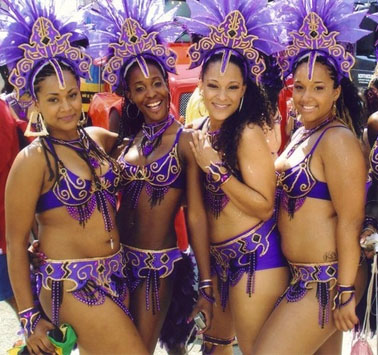
Meanwhile, 338Canada.com (“Last update: August 4th 2019”) rather similarly gives the Liberals 152 seats with 32.7% of the cross-Canada popular vote.
The Conservatives, once again, get a slightly greater share of the popular vote (34%) but only 146 seats. The NDP have 22 seats with 14.4% of the vote, and the Greens 6 seats with 10.9%.
In both these cases the minority governing Trudeau Liberals would need support from the Singh New Democrats to get their budgets (and other key legislation) passed by the House (158 + 24 = 182 or 12 more than a bare majority ; or 152 +22 = 174 or 4 more than the minimum).
Alternatively, on the CalculatedPolitics.com numbers, even if the Scheer Conservatives were to somehow win support from both the NDP and the Greens they would still be one seat shy of even a bare majority in the House. But on the 338Canada.com numbers the Conservatives would have a working legislative majority (174) if they won support from both New Democrats and Greens.
Adding all this up – very casually on your pocket calculator while stretched out on the beach, or comfortably seated in a chair on the dock beside a gin and tonic – you might conclude that the most stable government possible from actual October 21 results like those currently predicted by
CalculatedPolitics.com and 338Canada.com would be a Liberal minority government, at least informally supported in the House by both the Singh New Democrats and the May Green Party.
And if (after two or three more gin and tonics by the dock – or possibly some now legal cannabis) you take this present-day summary altogether more seriously than is at all prudent, maybe the current CalculatedPolitics.com/338Canada.com scenario is what Justin Trudeau, Jagmeet Singh, and Elizabeth May were trying on for size, as they marched together in the August 4, 2019 Pride Parade in Vancouver, on Canada’s beautiful Pacific coast …
